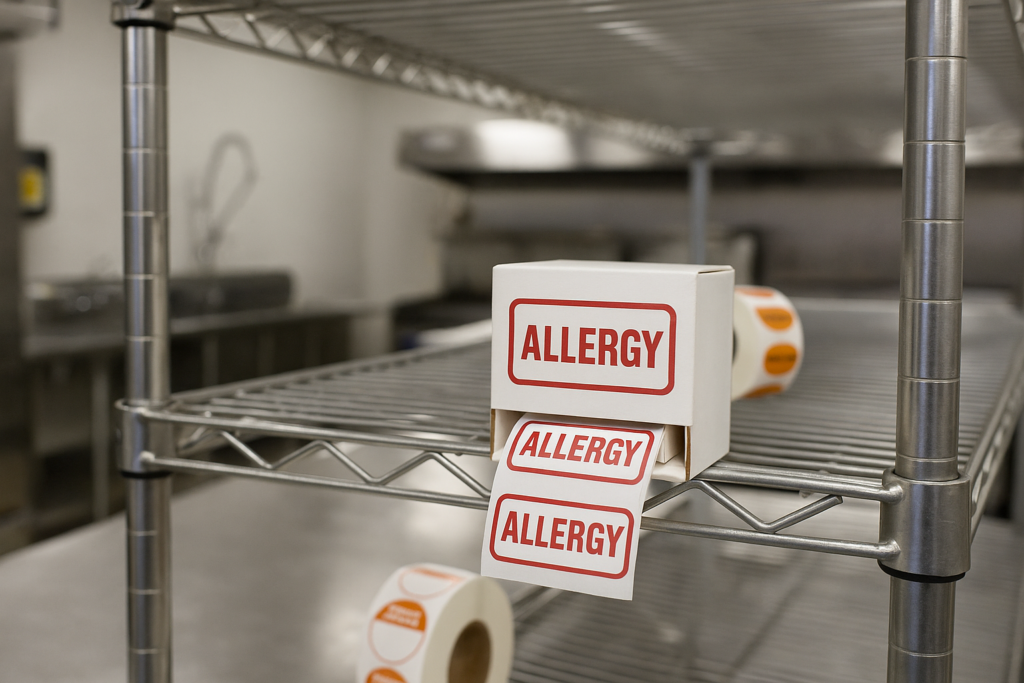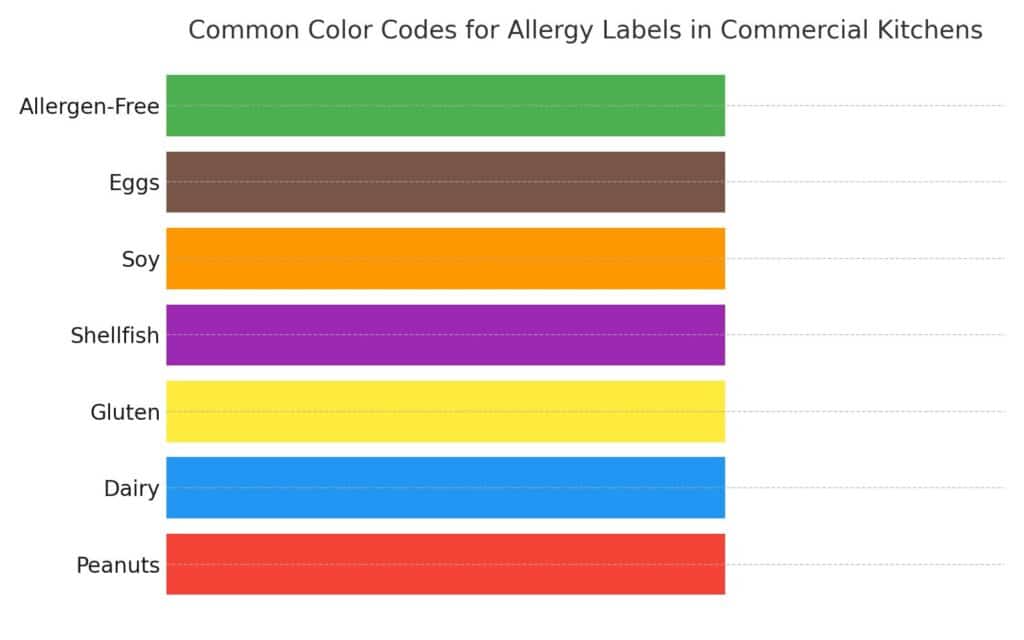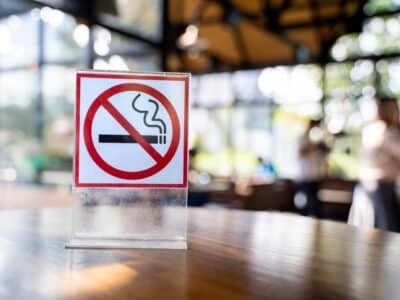How to Use Allergy Labels in Commercial Kitchens
To use allergy labels in a commercial kitchen, start by applying them directly to ingredient containers, prep tools, packaging, and storage zones—anywhere allergens are present or need to be avoided. These labels help staff quickly identify food allergens, reduce cross-contact risks, and keep your kitchen safe for customers with dietary sensitivities.
Used the right way, allergy labels become a fast, reliable part of your food safety system. They’re not just stickers—they’re a line of defense against accidental exposure, confusion during prep, and costly compliance issues during inspections.
What Are Allergy Labels and Why Do They Matter in a Kitchen?

Allergy labels are food-safe identifiers used to alert staff to the presence—or intentional absence—of major allergens like peanuts, dairy, gluten, soy, or shellfish. They’re often color-coded, clearly printed, and placed on everything from prep containers to plating tickets.
How They Prevent Cross-Contact and Food Allergy Reactions
Cross-contact happens when allergens unintentionally transfer to an allergen-free dish. One missed label can cause a health emergency. By using allergy-specific labels, kitchen teams reduce the risk of mistakes—especially in high-volume or multi-allergen environments.
How They Support Health Code Compliance and FDA Guidance
The FDA requires labeling of the top 9 allergens in packaged foods, and many commercial kitchens follow similar guidelines to avoid liability. Allergy labels help show inspectors and customers that you take allergen control seriously.
Where to Place Allergy Labels in a Commercial Kitchen
- On ingredient bins with allergen contents
- On prepared food containers or to-go packaging
- On plating tickets or prep sheets
- On storage shelves in allergen-free zones
The key is visibility—everyone from prep cooks to line chefs should instantly recognize the meaning behind each label.
Color Coding and Labeling by Allergen Type
Many kitchens use a color-coded system to make identification faster. For example:
- Red = peanuts
- Blue = dairy
- Yellow = gluten
- Green = allergen-free
This quick visual cue is especially helpful in fast-paced service or when language barriers exist among staff.

Tips for Allergen-Safe Labeling During Prep and Service
- Use dedicated prep areas and label them clearly
- Label dishes immediately after plating, before they hit the pass
- Train staff to double-check allergen labels before service
- Make sure label materials match the use case (e.g., waterproof for cold storage)
Allergy Label Materials That Actually Work
Dissolvable vs. Permanent for Allergen Zones
Use dissolvable labels for containers that are washed and reused often—great for prep bowls or food bins. Permanent allergy labels work well for designated cutting boards, utensils, or storage shelves that should never come in contact with allergens.
Waterproof or Freezer Safe for Cold Holding Areas
If your kitchen preps ahead or chills dishes, make sure allergy labels are waterproof or freezer-safe. Otherwise, ink can smear or labels fall off, defeating the purpose.
Real-Life Examples of Allergy Labeling Done Right
A School Cafeteria’s Nut-Free Zone
One public school in Illinois labels every lunch tray with a colored allergy dot based on the student’s known dietary needs. The kitchen team uses pre-printed stickers with allergens clearly listed (e.g., “Nut-Free”) to reduce errors. Since implementation, incidents dropped to zero.
A Deli That Reduced Allergy Incidents with Labels
A small-town deli introduced color-coded labels on their sandwich wraps and prep counters. Blue = dairy, red = peanuts, and green = allergen-free. This simple change led to fewer mistakes and better customer trust—plus smoother health inspections.
A Quick Tip to Help Your Staff Stay Consistent
Keep a label key chart visible in the kitchen that explains what each allergy label color or phrase means. Update it during staff training or when ingredients change. Consistency reduces confusion and keeps everyone on the same page.
A Helpful Next Step
If you’re setting up a better allergen system or revisiting your food safety protocols, having the right labeling tools is a great place to start. We offer food allergy labels made for commercial kitchen conditions—think freezer-safe, waterproof, or dissolvable options to match your workflow.
Frequently Asked Questions
What should be on an allergy label?
At minimum, allergy labels should list the allergen present (e.g., “Contains: Soy”), or clearly indicate absence (e.g., “Gluten-Free”). Color coding adds extra clarity.
Where should I place allergy labels in the kitchen?
Labels should go on ingredient containers, food trays, prep tickets, and allergen-specific tools or zones. Place them where they can’t be missed during prep or service.
What color is used for allergy labeling?
There’s no universal standard, but many kitchens use:
- Red for peanuts
- Yellow for gluten
- Blue for dairy
- Green for allergen-free
Just be consistent—and train your staff.
Are allergy labels required by the FDA?
Yes, the FDA requires allergen labeling for packaged foods, especially for the top 9 major allergens (like peanuts, dairy, and shellfish). However, in restaurants and commercial kitchens, it’s not federally required—regulations vary by state or local health departments.
Still, using allergy labels voluntarily is a smart safety measure. It shows your kitchen prioritizes food safety, reduces liability risks, and often earns positive marks during inspections.
How do I avoid cross-contact in labeling?
To prevent cross-contact, always label allergen-containing items using clean, dry, and dedicated containers. Apply allergy labels before the item enters storage or service so staff are alerted early.
Use separate utensils, color-coded cutting boards, and prep zones for allergen-free items. Train all team members on the labeling system and double-check orders involving known food allergies before they go out.
Can allergy labels be reused?
It’s not recommended. Even if a label looks clean, reusing it can cause confusion or lead to incorrect assumptions about what’s inside. Labels can lose adhesion or be misread after handling. Best practice? Use a fresh allergy label for every new prep batch or container. It takes seconds and eliminates the risk of cross-contact due to labeling errors.
What’s the difference between allergen-free and allergy-friendly labels?
“Allergen-free” means the food contains none of the specific allergens (like dairy or peanuts), often with strict protocols to prevent cross-contact. “Allergy-friendly” typically means it’s made without certain allergens, but may be produced in a shared facility—so it’s important to clarify.
How often should allergy labels be replaced or updated?
Labels should be replaced every time a container is reused, an ingredient changes, or a dish is remade. Using fresh labels avoids confusion and ensures that allergen information stays accurate for every meal and shift.




